
St. Anne's Episcopal Church is a historic church at 29 Church Street in Calais, Maine. Built in 1853, it is a locally distinctive example of Carpenter Gothic architecture, and is the only known statewide work of architect James Renwick Jr. The church building was listed on the National Register of Historic Places in 1982. It is a member of the Episcopal Diocese of Maine; its pastor is the Rev. Sara Gavit.

The First Universalist Church is a historic church building on the corner of Pleasant, Elm, and Spring Streets in Auburn, Maine. It was built in 1876 to a design by John Stevens of Boston, Massachusetts, and has been a significant landmark in the city since its construction. It is a fine local example of Gothic Revival architecture executed in brick, and was listed on the National Register of Historic Places in 1979.

St. Cyril and St. Methodius Church is an historic former church building at 51 Main Street in Lisbon Falls, Maine. The church was designed in 1923 by Lewiston architects Gibbs & Pulsifer, and is an imposing example of neo-Gothic architecture for a relatively small community. It is also the only known church in Maine with association to the Slovak immigrant community. It was dedicated in 1926 and added to the National Register of Historic Places in 1977. It is presently home to the Maine Art Glass Studio.
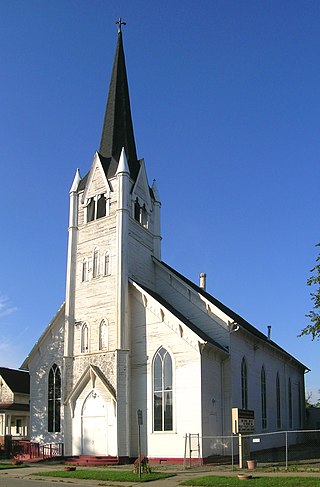
The Gethsemane Evangelical Lutheran Church is a church located at 4461 Twenty-Eighth Street in Detroit, Michigan. It was designated a Michigan State Historic Site in 1980 and listed on the National Register of Historic Places in 1982. The building now houses the Motor City Missionary Baptist Church.
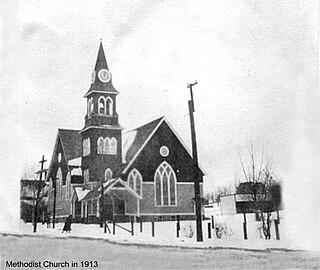
The Gray Memorial United Methodist Church and Parsonage is a historic church complex at 8 Prospect Street in Caribou, Maine. The Gothic Revival wood-frame church, built in 1912-14 for a Methodist congregation founded in 1860, is the most architecturally sophisticated church in Caribou. It was built on the lot of the Colonial Revival parsonage house, which was moved to make way for the church. The complex was listed on the National Register of Historic Places in 1995. The current pastor is Pastor Richard Rego.

The Gustaf Adolph Lutheran Church is a historic church at 29 Capitol Hill Road in New Sweden, Maine. The congregation was established by Swedish immigrants to the area in 1871, and the Gothic Revival sanctuary was built in 1879-80. In 1896 the church was named in honor of King Gustavus Adolphus of Sweden. It was listed on the National Register of Historic Places in 1997. The church congregation was in 2003 subjected to one of the nation's largest cases of arsenic poisoning, perpetrated by one of its parishioners.
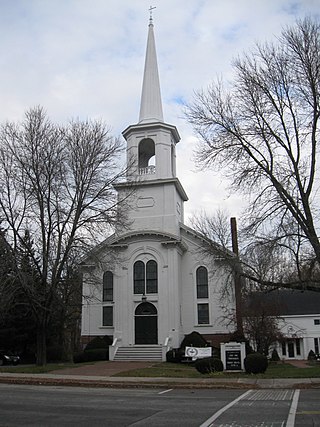
The First Universalist Church, also once known as the Central Parish Church, is a historic church at 97 Main Street in Yarmouth, Maine. Built in 1859–60, it is an excellent local example of religious Italianate architecture, and one of the state's few surviving churches designed by architect Thomas Holt. It was listed on the National Register of Historic Places in 1988. The congregation was founded in 1859, and is affiliated with the Unitarian Universalist Association; its current minister is Rev. Hillary Collins-Gilpatrick.
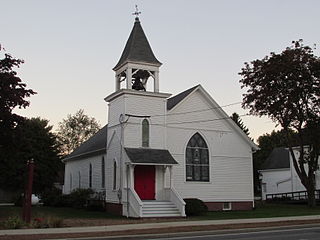
The West Scarborough United Methodist Church, also known as the Dunstan Methodist Episcopal Church, is a historic church on U.S. Route 1 in Scarborough, Maine. The church building, built in 1839 and extensively altered in 1907, is one of the few surviving works of Maine architect and artist Harry Hayman Cochrane. The building was listed on the National Register of Historic Places in 1989 for its architectural significance.

The North Yarmouth and Freeport Baptist Meetinghouse, also known as the Old Baptist Meeting House, is an historic church on Hillside Street in Yarmouth, Maine. Built in 1796 and twice altered in the 19th century, it is believed to be the oldest surviving church built for a Baptist congregation in the state of Maine. It is now owned by the town and maintained by a local non-profit organization.
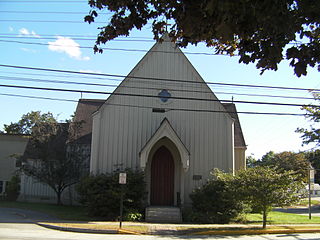
St. Paul's Episcopal Church is a historic church at 27 Pleasant Street in Brunswick, Maine. Built in 1845, it is a distinctive early example of a modest Carpenter Gothic design by Richard Upjohn, then already well known for his larger-scale Gothic churches. The building was listed on the National Register of Historic Places in 1978. The rector is Rev. Carolyn H. Eklund.

St. Mark's Episcopal Church was a historic church at 9 Summer Street in Augusta, Maine, just west of downtown. The congregation, founded in 1840, occupied an 1886 Gothic Revival stone building designed by Richard M. Upjohn and listed on the National Register of Historic Places in 1984 for its architecture. The congregation moved out in 2015.

Damariscotta Baptist Church is a historic church at 4 Bristol Road in Damariscotta, Maine, United States. Built in 1843-47 and restyled in 1891, it is a well-preserved example of Greek Revival and Colonial Revival architecture. The building also played a role in the formation of the town, and was listed on the National Register of Historic Places in 1985.
Winterport Congregational Church, originally and once again the Winterport Union Meeting House, is a historic church at 177 Main Street in Winterport, Maine. Built in 1831, it is a prominent little-altered example of Gothic Revival architecture, designed and built by Calvin Ryder, a well-known regional architect and builder. It was listed on the National Register of Historic Places in 1973.
Dexter Universalist Church, or the First Universalist Church of Dexter, is a historic church on Church Street in Dexter, Maine. Built in the 1820s and restyled in the 1860s, it is a distinctive work of Boston, Massachusetts architect Thomas Silloway. The building was listed on the National Register of Historic Places in 1985.

Gethsemane Lutheran Church is a historic Lutheran church in downtown Austin, Texas. Designated as a Recorded Texas Historic Landmark and listed on the National Register of Historic Places, the building currently holds offices of the Texas Historical Commission.

St. Paul's Episcopal Church is a parish church in the Diocese of Iowa. The church is located in Harlan, Iowa, United States. It has been listed on the National Register of Historic Places in 1978.

St. Peder's Dansk Evangelical Lutheran Kirke is a historic church at 1796 7th Avenue in Nysted, Nebraska. It was built in 1919 and was added to the National Register of Historic Places in 2007.
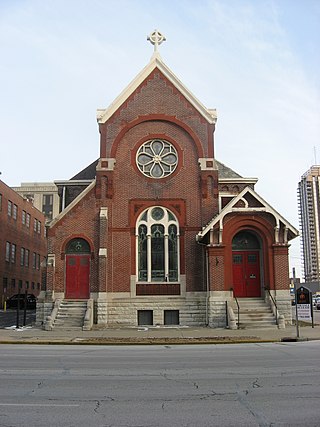
Mount Pisgah Lutheran Church, also known in its early years as the First Lutheran Church and First English Lutheran Church and more recently as The Sanctuary on Penn, is located at 701 North Pennsylvania Street in downtown Indianapolis, Indiana. The historic church was built by the city's first Lutheran congregation, which organized in 1837, and was its third house of worship. The former church, whose present-day name is The Sanctuary on Penn, is operated as a for-profit event venue.

Memorial Hall is a historic meeting hall at South Main and Elm Streets in Windsor Locks, Connecticut. Built in 1890 as a memorial to the town's American Civil War soldiers, it has served for most of its existence has a meeting place for veterans' organizations, from the Grand Army of the Republic to the American Legion. It is also one of the town's finest examples of Romanesque architecture, and was listed on the National Register of Historic Places in 1987.

West Paint Creek Synod Evangelical Lutheran Church and Cemetery is a historic building and site located northwest of Waterville, Iowa, United States. The church building and its adjacent cemetery were listed together on the National Register of Historic Places in 2019.




















